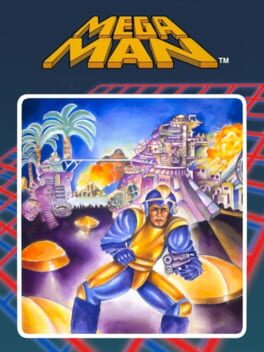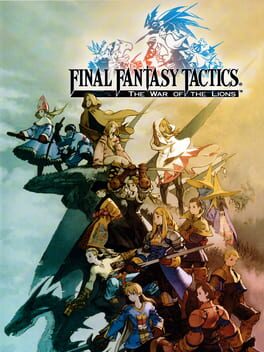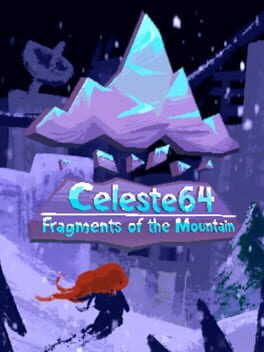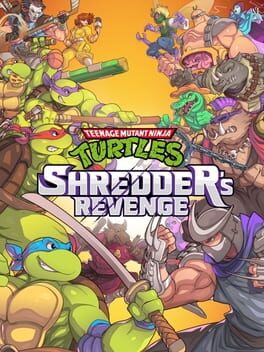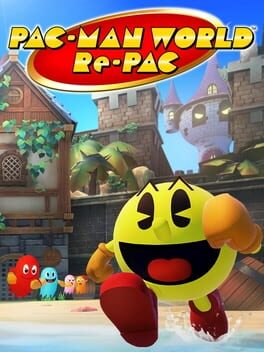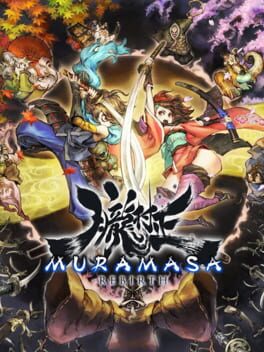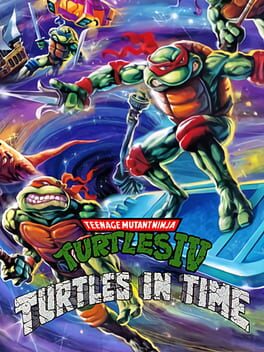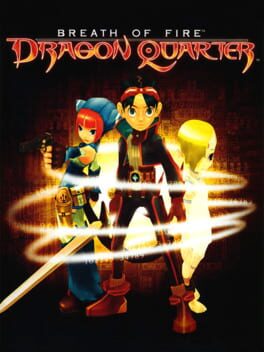hail_freyr
34 Reviews liked by hail_freyr
Mega Man
1987
*Both replays of Mega Man 1 was played through the Legacy Collection.
Mega Man 1 is a solid foundation to an iconic series. The basics are there: jump, shoot, going through levels, beating up robot masters, and getting their abilities. The elements that formulate every Mega Man game came from here. Music is excellent and the visuals are classic, though the backgrounds are pretty basic by NES standards. Only flaws I have is Mega Man's stiff movement through jumps, the Wily Castle bosses, and some enemy placements were cheap. Overall, a solid game that gets beaten out by its sequels.
Mega Man 1 is a solid foundation to an iconic series. The basics are there: jump, shoot, going through levels, beating up robot masters, and getting their abilities. The elements that formulate every Mega Man game came from here. Music is excellent and the visuals are classic, though the backgrounds are pretty basic by NES standards. Only flaws I have is Mega Man's stiff movement through jumps, the Wily Castle bosses, and some enemy placements were cheap. Overall, a solid game that gets beaten out by its sequels.
Shadow Tower
1998
Shadow Tower is a very polished version of this game style From had been iterating on. It runs really well and looks better than the King's Field games up to this point, but I didn't find the gothic horror vibe with no real underlying story or lore to be quite as compelling.
The environments are all varied and identifiable and range through five major zones, each split into a number of discrete levels. Each of the zones is ruled over by a boss which you must defeat in order to challenge the King of Demons and complete the game. This is an even more straightforward dungeon crawl than King's Field was.
Smaller levels and lower draw distances add to the claustrophobic feel of the game and are probably what allow the more detailed environment art and enemy models. These environments are varied and make the levels interesting to explore, but don't seem to have much coherency in terms of the world itself. The layouts of the actual levels are intricate and mazelike, although the level design (along with the detail and size) makes things very navigable.
The layout here feels like you are meant to explore the tower in spurts, sallying out from safe areas even though the level design has a lot of back-gating (ascending out of the tower can be overly difficult or impossible) which unfortunately undermines this. It does add to the palpable sense of dread as you become more and more unsure of your path back to safety.
This is the first person melee combat we know from King's Field with some minor differences (including a solid framerate). You move and turn a bit faster and your initial attack range is abysmally low (later weapons mostly fix this problem, but it never feels quite permissive enough). Shadow Tower doesn't feel that good to play until you get a bit in and find a few weapons you like and some magic that works, at which point things smooth out. I never really reached the overpowered status that the end of King's Field games impart upon you, but I felt capable and strong by the end, though death can always come quickly if you aren't paying close enough attention.
Shadow Tower has a lot of magic options, but I didn't find them to be too interesting in the end. You collect rings as you play, each providing you with minor stat increases and the ability to cast a set of spells. Most of the spells are some variation on a projectile attack, the timing of which allow you to weave them between sword swings just like in past games. I didn't find much value in making specific choices about spells, and just kind of used them arbitrarily throughout the game (mostly forced by the resource system).
The most interesting thing in Shadow Tower is absolutely the resource system.
Every weapon, armor, and spell-casting ring has durability which wears down extremely quickly. It isn't uncommon for a ring to only provide six or seven spell casts, a weapon 15-20 swings before they break (temporarily) requiring you to swap to something else. These can all be fixed at special vendors that can use your hit points (their dialog implies they are using parts of your body, which is pretty metal) to repair all your stuff -- you constantly feel like you are making the choice between survival and offensive ability.
Weapons and equipment you don't need can be traded at other vendors for health and magic potions (both of which fill their respective pools to max and can also be found around the tower).
It really feels like you are making purposeful choices about which weapons you need and which you can afford to trade to fuel your hit points and (at least at the beginning of the game) which weapons you need to fix in order to progress and how much of your life you are willing to give up to do so.
Your health as the main resource is so interesting! Since everything in the game ties back to this (not least of which the exploration and combat itself) it is something you are constantly thinking about and further adds to the pervasive sense of horror this game is trying to provide.
Overall this is a very unique and cool system even though your inability to partially fix things can make things awkward and it largely falls away by the end of the game as your health pool and supply of potions become so large that they cease to really be a concern (at which point weapon degradation just becomes a minor annoyance as you switch weapons every few minutes).
This game is almost one hundred percent about the vibes, with no real discernable narrative or lore to be found. Similar to King's Field, you are following a group of soldiers into this dungeon, but there isn't really a motivating factor (the manual has a perfunctory justification about an inn-keeper you are saving/avenging and her cooking). You are in this tower because it is here and it has demons in it because it is evil. Some of the bosses, scant few NPCs, and wall messages hint at greater powers and demonic machinations, but it doesn't really come to much by the end, with the final cutscene being both unclear and unsatisfying.
Alongside the gameplay and combat, the thing I most like about From Software games is thinking about the Why of it all and Shadow Tower just isn't so interested in providing that part of it. I still had fun with the game (it is among the better versions so far of this heavy, purposeful, first-person combat From is perfecting), but it didn't hit for me as hard as King's Field II or any of the suite of Soulsborne games that are in From's future.
The environments are all varied and identifiable and range through five major zones, each split into a number of discrete levels. Each of the zones is ruled over by a boss which you must defeat in order to challenge the King of Demons and complete the game. This is an even more straightforward dungeon crawl than King's Field was.
Smaller levels and lower draw distances add to the claustrophobic feel of the game and are probably what allow the more detailed environment art and enemy models. These environments are varied and make the levels interesting to explore, but don't seem to have much coherency in terms of the world itself. The layouts of the actual levels are intricate and mazelike, although the level design (along with the detail and size) makes things very navigable.
The layout here feels like you are meant to explore the tower in spurts, sallying out from safe areas even though the level design has a lot of back-gating (ascending out of the tower can be overly difficult or impossible) which unfortunately undermines this. It does add to the palpable sense of dread as you become more and more unsure of your path back to safety.
This is the first person melee combat we know from King's Field with some minor differences (including a solid framerate). You move and turn a bit faster and your initial attack range is abysmally low (later weapons mostly fix this problem, but it never feels quite permissive enough). Shadow Tower doesn't feel that good to play until you get a bit in and find a few weapons you like and some magic that works, at which point things smooth out. I never really reached the overpowered status that the end of King's Field games impart upon you, but I felt capable and strong by the end, though death can always come quickly if you aren't paying close enough attention.
Shadow Tower has a lot of magic options, but I didn't find them to be too interesting in the end. You collect rings as you play, each providing you with minor stat increases and the ability to cast a set of spells. Most of the spells are some variation on a projectile attack, the timing of which allow you to weave them between sword swings just like in past games. I didn't find much value in making specific choices about spells, and just kind of used them arbitrarily throughout the game (mostly forced by the resource system).
The most interesting thing in Shadow Tower is absolutely the resource system.
Every weapon, armor, and spell-casting ring has durability which wears down extremely quickly. It isn't uncommon for a ring to only provide six or seven spell casts, a weapon 15-20 swings before they break (temporarily) requiring you to swap to something else. These can all be fixed at special vendors that can use your hit points (their dialog implies they are using parts of your body, which is pretty metal) to repair all your stuff -- you constantly feel like you are making the choice between survival and offensive ability.
Weapons and equipment you don't need can be traded at other vendors for health and magic potions (both of which fill their respective pools to max and can also be found around the tower).
It really feels like you are making purposeful choices about which weapons you need and which you can afford to trade to fuel your hit points and (at least at the beginning of the game) which weapons you need to fix in order to progress and how much of your life you are willing to give up to do so.
Your health as the main resource is so interesting! Since everything in the game ties back to this (not least of which the exploration and combat itself) it is something you are constantly thinking about and further adds to the pervasive sense of horror this game is trying to provide.
Overall this is a very unique and cool system even though your inability to partially fix things can make things awkward and it largely falls away by the end of the game as your health pool and supply of potions become so large that they cease to really be a concern (at which point weapon degradation just becomes a minor annoyance as you switch weapons every few minutes).
This game is almost one hundred percent about the vibes, with no real discernable narrative or lore to be found. Similar to King's Field, you are following a group of soldiers into this dungeon, but there isn't really a motivating factor (the manual has a perfunctory justification about an inn-keeper you are saving/avenging and her cooking). You are in this tower because it is here and it has demons in it because it is evil. Some of the bosses, scant few NPCs, and wall messages hint at greater powers and demonic machinations, but it doesn't really come to much by the end, with the final cutscene being both unclear and unsatisfying.
Alongside the gameplay and combat, the thing I most like about From Software games is thinking about the Why of it all and Shadow Tower just isn't so interested in providing that part of it. I still had fun with the game (it is among the better versions so far of this heavy, purposeful, first-person combat From is perfecting), but it didn't hit for me as hard as King's Field II or any of the suite of Soulsborne games that are in From's future.
Pac-Man World Re-Pac
2022
Muramasa Rebirth
2013
Played both versions of this (both the arcade one and the SNES one) in the The Cowabunga Collection. The arcade version was pretty lame to play mainly due to the random difficulty spikes and the tank enemies. The SNES version was way more approachable and fun. However, the arcade one totally wins when it comes to the animation department. So many cute little animations that were just ignored on the SNES. The SNES still wins over it and it's the one to play for sure.
Breath of Fire III
1997
inner monologue: okay, you can do this, just tell everyone how important this game was to you in your formative years and how it represents a kind of nostalgia for a time past that you'll never reclaim; that this game, in essence, represents the hopefulness of youth
...rei.... titty big
inner monologue: goddammit that's it, i'm outta here
...rei.... titty big
inner monologue: goddammit that's it, i'm outta here
Breath of Fire III
1997
I wrote in a review a while ago for A Girl and the Robot what a shallow copy of Ico it was and simply playing that instead was better than the unimaginative clone that came many years later. The thing is that wearing your inspiration on your sleeve isn't always a bad thing and in the case of Record of Lodoss War: Deedlit in Wonder Labyrinth (who named this? Were they trying to get a good scrabble score?) I think it's obvious Symphony of the Night references are somewhat to the game's credit for making it a fun little Metroidvania title. Having said that though the way the titular character Deedlit moves, her first few steps, her backdash leaving a ghostly shimmer, the long hair, She's almost a palette swap of Alucard from Castlevania. There is taking inspiration, then there is getting out tracing paper.
Still, it does bring some unique mechanics into the game on it's own merit. Deedlit can swap between two different elements regardless of the weapons she wields of fire and..wind?. This is used for both fighting enemies and finding their weakness as well as puzzles and bosses where being on the right element being hit by it allows you to escape unharmed as well as build up spell power. It's a cool little system that in some ways reminded me of aspects of Ikaruga. I wish they leaned into this mechanic a little harder though with more creative puzzles, platforming and bosses using it, maybe an extra element to boot rather than just the two. It's a clever interesting little system giving it a unique selling point, it's just kind of underbaked.
The rest of the game is a pretty standard affair of exploring and backtracking to unlock the map getting new weapons and armour and fighting bosses. Some of the bosses as mentioned above are genuinely pretty good fun, though you can abuse the elemental mechanic on some of them far too easily. There is a dragon that only throws fire at you you can be immune to in fire mode that constantly generates you mana so you just spam spells in his face whilst invincible for example. A few more require tricky changing of elements and timing between attacks to hit which I enjoyed far more and would have liked to see developed further for more memorable fights.
That's my issue generally actually, the elemental aspect could be better, the fights could be better, the map could be more interesting. It's a good game, I had fun with it but it feels like missed potential wrapped up in a completely nonsensical story for anyone not familiar with the manga or anime I presume.
Still, it does bring some unique mechanics into the game on it's own merit. Deedlit can swap between two different elements regardless of the weapons she wields of fire and..wind?. This is used for both fighting enemies and finding their weakness as well as puzzles and bosses where being on the right element being hit by it allows you to escape unharmed as well as build up spell power. It's a cool little system that in some ways reminded me of aspects of Ikaruga. I wish they leaned into this mechanic a little harder though with more creative puzzles, platforming and bosses using it, maybe an extra element to boot rather than just the two. It's a clever interesting little system giving it a unique selling point, it's just kind of underbaked.
The rest of the game is a pretty standard affair of exploring and backtracking to unlock the map getting new weapons and armour and fighting bosses. Some of the bosses as mentioned above are genuinely pretty good fun, though you can abuse the elemental mechanic on some of them far too easily. There is a dragon that only throws fire at you you can be immune to in fire mode that constantly generates you mana so you just spam spells in his face whilst invincible for example. A few more require tricky changing of elements and timing between attacks to hit which I enjoyed far more and would have liked to see developed further for more memorable fights.
That's my issue generally actually, the elemental aspect could be better, the fights could be better, the map could be more interesting. It's a good game, I had fun with it but it feels like missed potential wrapped up in a completely nonsensical story for anyone not familiar with the manga or anime I presume.
Breath of Fire: Dragon Quarter is a really excellent RPG with some awesome and unique ideas that make up for its few narrative missteps and mechanical opacity. This is the best and most interesting Breath of Fire game.
The visuals and music in Dragon Quarter are great. The character models are well done and expressive and the environments are varied and look good.
The music is definitely a high point, a lot of it is reminiscent of Final Fantasy Tactics and Vagrant Story (same composer) and it sounds fantastic throughout the game.
The narrative here is very cool to begin with but runs out of steam towards the end. You play as a 'Ranger' in an underground, post apocalyptic society that seems to have formed after a disaster on the surface of the world, making it unlivable in some way. Over the course of the game you meet Nina, a girl who is a lab experiment of some kind, and Lin, a member of a resistance organization. These three main characters are cool spins on the Breath of Fire main cast (Dragon Boy, Flying Girl, and Cat Person), and it makes this game feel like a weird, far-future version of a Breath of Fire game.
The story itself is contained and drives forward effectively. The world and factions are all interesting and the game generally doesn't try to do too much. There are a lot of really good character moments and the graphical style and animations convey feelings really effectively. There are more than a few very striking character reactions of sadness and horror that are among the most effective I have seen in games.
Near the end the game throws in what is basically a boss gauntlet of a bunch of barely foreshadowed members of some organization that vaguely controls the Rangers and isn't really involved in the story up to that point. It all feels very disconnected and low stakes, even though they hint at some sort of metaphysical connection between these characters. It didn't work for me and just distracted from the main through-line of Nina trying to get to the surface with Ryu and Lin's help (plus interference and rivalry with the Rangers).
Exploration is fun, with distinctive, not-overly confusing dungeons and the ability to start combat by attacking enemies on the field. The environments look cool, in that classic PS2 sort of way, and even though most of it is underground and dark, there is a lot of variety to the areas you travel through.
There is also a fairy cave mini-game where you recruit ants to do various jobs. shrug Breath of Fire.
Combat in Dragon Quarter is tactical. Characters have action points they can spend on movement and attacks in a fairly straight-forward way. There is a twist that works pretty well, where you can build combos from abilities you have 'threaded' onto your weapons. Abilities have different costs and how they are set up in the weapon and how you string them together brings a lot of depth to the system. Each of the three characters also has things they are better at and each feels distinct to play, in terms of their actual abilities and how they combo them together.
Additionally, the main character can use a special dragon mode that gives him new abilities and can kill literally every enemy in the game in one turn. You have a percentage counter and if it hits 100% at any point, it is game over! This seems insane, but manipulating this counter is an integral part of the game that feeds elegantly into...
The real innovation in Dragon Quarter comes, strangely, from the save system which is, unfortunately, very opaque and weird. Getting your head around (and even remembering) how it works is definitely a challenge.
It comes down to basically one menu option (SOL Restore) that you can do whenever you want (and it triggers automatically if you die, which shouldn't ever happen). Using this overwrites certain aspects of your save file and boots you back to the main menu, letting you load your newly altered save. When you load, you are back at the location from the save file, at the level you were when you made it with a minimal set of items and (Importantly!) your dragon percentage at whatever it was when you saved. From the SOL Restore, you get your weapon inventory, item bank, any new skills you found, and your cash and freely assignable party experience points. This is all very complicated and seems arbitrary, but the bottom line is that the game wants you to save before a new area, then run through the upcoming dungeon using your dragon abilities to trivialize it (gaining massive amounts of party exp because of efficiency bonuses) while you pick up new weapons, learn new skills, and loot a bunch of stat bonus items. Then you SOL Restore (which resets your levels and dragon counter) distribute your party experience and use your stat bonus items, save, and do it again until you can easily make it through the dungeon without needing dragon form at all. Basically, a unique, interesting form of grinding is built fundamentally into the mechanics of the game that make it almost feel like a roguelike.
The SOL Restore system makes the dragon form work! You can use this massively powerful, fun form as much as you want to learn the level and defeat hard, optional side enemies then reset your counter and keep most of your rewards!
The level design exploits the SOL Restore system! The main path through a level is almost always short and straight, so once you learn the level and have gotten every item and skill out of it, you can just run right through to the next part of the game!
The system lets you bring weapons from the future back to help you in the past! You can run up to the boss of the level, steal their sword, SOL Restore, then use it to kill them!
New narrative events happen the second and third times through an area, so SOL Restore has some additional reward for effectively using it!
There are a few missteps with this system, unfortunately.
There is an additional SOL Restart feature, which does the same thing as SOL Restore, but sends you back to the beginning of the game. I think you would never want to do this, and it seems like it is included so that there can be a newgame+?
Saving is unnecessarily annoying, with a dependency on sparse save terminals and a pseudo-rare item (that is part of your basic SOL Restore inventory). The game would just be better if it let you save at every terminal for free.
A couple of things don't carry over but should, which just makes things fiddly. If SOL Restore saved new backpack slots, used stat items, and applied party experience the whole thing would just work more smoothly without losing anything.
All that aside, it is hard to express how awesome and unique the SOL system is and how much it truly impacts the game. It is really a triumph of game design that brings Dragon Quarter from 4 stars up to 5 for me, despite its other minor shortcomings. This game is worth checking out... just give it a chance to teach you how to play it and you will have a good time with its unique take on RPG advancement, interesting world, and solid, turn-based combat.
The visuals and music in Dragon Quarter are great. The character models are well done and expressive and the environments are varied and look good.
The music is definitely a high point, a lot of it is reminiscent of Final Fantasy Tactics and Vagrant Story (same composer) and it sounds fantastic throughout the game.
The narrative here is very cool to begin with but runs out of steam towards the end. You play as a 'Ranger' in an underground, post apocalyptic society that seems to have formed after a disaster on the surface of the world, making it unlivable in some way. Over the course of the game you meet Nina, a girl who is a lab experiment of some kind, and Lin, a member of a resistance organization. These three main characters are cool spins on the Breath of Fire main cast (Dragon Boy, Flying Girl, and Cat Person), and it makes this game feel like a weird, far-future version of a Breath of Fire game.
The story itself is contained and drives forward effectively. The world and factions are all interesting and the game generally doesn't try to do too much. There are a lot of really good character moments and the graphical style and animations convey feelings really effectively. There are more than a few very striking character reactions of sadness and horror that are among the most effective I have seen in games.
Near the end the game throws in what is basically a boss gauntlet of a bunch of barely foreshadowed members of some organization that vaguely controls the Rangers and isn't really involved in the story up to that point. It all feels very disconnected and low stakes, even though they hint at some sort of metaphysical connection between these characters. It didn't work for me and just distracted from the main through-line of Nina trying to get to the surface with Ryu and Lin's help (plus interference and rivalry with the Rangers).
Exploration is fun, with distinctive, not-overly confusing dungeons and the ability to start combat by attacking enemies on the field. The environments look cool, in that classic PS2 sort of way, and even though most of it is underground and dark, there is a lot of variety to the areas you travel through.
There is also a fairy cave mini-game where you recruit ants to do various jobs. shrug Breath of Fire.
Combat in Dragon Quarter is tactical. Characters have action points they can spend on movement and attacks in a fairly straight-forward way. There is a twist that works pretty well, where you can build combos from abilities you have 'threaded' onto your weapons. Abilities have different costs and how they are set up in the weapon and how you string them together brings a lot of depth to the system. Each of the three characters also has things they are better at and each feels distinct to play, in terms of their actual abilities and how they combo them together.
Additionally, the main character can use a special dragon mode that gives him new abilities and can kill literally every enemy in the game in one turn. You have a percentage counter and if it hits 100% at any point, it is game over! This seems insane, but manipulating this counter is an integral part of the game that feeds elegantly into...
The real innovation in Dragon Quarter comes, strangely, from the save system which is, unfortunately, very opaque and weird. Getting your head around (and even remembering) how it works is definitely a challenge.
It comes down to basically one menu option (SOL Restore) that you can do whenever you want (and it triggers automatically if you die, which shouldn't ever happen). Using this overwrites certain aspects of your save file and boots you back to the main menu, letting you load your newly altered save. When you load, you are back at the location from the save file, at the level you were when you made it with a minimal set of items and (Importantly!) your dragon percentage at whatever it was when you saved. From the SOL Restore, you get your weapon inventory, item bank, any new skills you found, and your cash and freely assignable party experience points. This is all very complicated and seems arbitrary, but the bottom line is that the game wants you to save before a new area, then run through the upcoming dungeon using your dragon abilities to trivialize it (gaining massive amounts of party exp because of efficiency bonuses) while you pick up new weapons, learn new skills, and loot a bunch of stat bonus items. Then you SOL Restore (which resets your levels and dragon counter) distribute your party experience and use your stat bonus items, save, and do it again until you can easily make it through the dungeon without needing dragon form at all. Basically, a unique, interesting form of grinding is built fundamentally into the mechanics of the game that make it almost feel like a roguelike.
The SOL Restore system makes the dragon form work! You can use this massively powerful, fun form as much as you want to learn the level and defeat hard, optional side enemies then reset your counter and keep most of your rewards!
The level design exploits the SOL Restore system! The main path through a level is almost always short and straight, so once you learn the level and have gotten every item and skill out of it, you can just run right through to the next part of the game!
The system lets you bring weapons from the future back to help you in the past! You can run up to the boss of the level, steal their sword, SOL Restore, then use it to kill them!
New narrative events happen the second and third times through an area, so SOL Restore has some additional reward for effectively using it!
There are a few missteps with this system, unfortunately.
There is an additional SOL Restart feature, which does the same thing as SOL Restore, but sends you back to the beginning of the game. I think you would never want to do this, and it seems like it is included so that there can be a newgame+?
Saving is unnecessarily annoying, with a dependency on sparse save terminals and a pseudo-rare item (that is part of your basic SOL Restore inventory). The game would just be better if it let you save at every terminal for free.
A couple of things don't carry over but should, which just makes things fiddly. If SOL Restore saved new backpack slots, used stat items, and applied party experience the whole thing would just work more smoothly without losing anything.
All that aside, it is hard to express how awesome and unique the SOL system is and how much it truly impacts the game. It is really a triumph of game design that brings Dragon Quarter from 4 stars up to 5 for me, despite its other minor shortcomings. This game is worth checking out... just give it a chance to teach you how to play it and you will have a good time with its unique take on RPG advancement, interesting world, and solid, turn-based combat.
Wild Arms 3
2002
"Heroes in a half shell, Turtle Power!"
When the opening animated scene starts playing the theme tune to the 1987 animated show I felt like I had been transported to my childhood again. Whilst Shredder's Revenge leans into that nostalgia bait with aplomb using cameos, some of the original voice cast and influence from Konami's original beat 'em up Turtles in Time, the thing is Shredder's Revenge is just a good game that respects the source material, but doesn't rely solely on it.
This game features 16 stages selected across a Super Mario World styled map you move the Turtle Van onto to select. There are 7 playable characters to play and though their basic move sets are identical in controls the attacks and animations are specific to each character based on their personality. Leonardo is very professional, Michelangelo does a dance yelling "party dude!" for his taunt, April smash's Foot clan in the face with camera equipment etc. There is a lot of love and care put into it. The actual combat is pretty simple with basic attacks, run attacks, a super various jump attacks and a dedicated dodge button. As you beat enemies of find collectables you gain experience and your character levels up gaining new moves or extra health. Though the game itself is fairly easy especially playing multiplayer (I've only tried two player with a friend so far but it goes up to six somehow) there are challenges for each level including some for not taking damage which offer a bit more of a skill based gameplay to aim for.
The thing I love most about this game though is how hard they nailed the aesthetic. The sprite work is wonderful, the art design is spot on and The Original Soundtrack Manages to sound both retro and modern at the same time done by Tee Lopes responsible for the sublime Sonic Mania OST.
This game is basically exactly what I wanted. Roll on the Cowabunga Collection.
+ Great references to the original animated show.
+ Fun game with a lot of heart.
+ Fantastic visual design.
+ Amazing modern/retro soundtrack.
When the opening animated scene starts playing the theme tune to the 1987 animated show I felt like I had been transported to my childhood again. Whilst Shredder's Revenge leans into that nostalgia bait with aplomb using cameos, some of the original voice cast and influence from Konami's original beat 'em up Turtles in Time, the thing is Shredder's Revenge is just a good game that respects the source material, but doesn't rely solely on it.
This game features 16 stages selected across a Super Mario World styled map you move the Turtle Van onto to select. There are 7 playable characters to play and though their basic move sets are identical in controls the attacks and animations are specific to each character based on their personality. Leonardo is very professional, Michelangelo does a dance yelling "party dude!" for his taunt, April smash's Foot clan in the face with camera equipment etc. There is a lot of love and care put into it. The actual combat is pretty simple with basic attacks, run attacks, a super various jump attacks and a dedicated dodge button. As you beat enemies of find collectables you gain experience and your character levels up gaining new moves or extra health. Though the game itself is fairly easy especially playing multiplayer (I've only tried two player with a friend so far but it goes up to six somehow) there are challenges for each level including some for not taking damage which offer a bit more of a skill based gameplay to aim for.
The thing I love most about this game though is how hard they nailed the aesthetic. The sprite work is wonderful, the art design is spot on and The Original Soundtrack Manages to sound both retro and modern at the same time done by Tee Lopes responsible for the sublime Sonic Mania OST.
This game is basically exactly what I wanted. Roll on the Cowabunga Collection.
+ Great references to the original animated show.
+ Fun game with a lot of heart.
+ Fantastic visual design.
+ Amazing modern/retro soundtrack.
Bloodborne
2015
Bloodborne is an amazing game. It has a fantastic, creative, and pervasive aesthetic that informs the excellent and engaging gameplay like few other games.
Playing Bloodborne feels great. It starts with a combat system reminiscent of Dark Souls, with a bit of speed and maneuverability added in. This added control feeds into the rally mechanic, which shifts things farther from the Dark Souls formula of favoring defense to demanding offense. This all matches the themes and feel of the world of Yharnam, allowing the unique setting to be perfectly supported by the gameplay differences.
Trick Weapons offer compelling, creative equipment choices throughout the game for any build you pursue. Learning your weapon's combos and using its switch form correctly feels awesome and further adds to the uniqueness of this game.
Bloodborne looks amazing. The world is dark and oppressive while spanning a variety of settings, you explore decaying, corrupted hamlets, towering, gothic cityscapes, and creepy, dread-inducing forests. So much of the game's environment design hits its themes perfectly and expertly gestures at new developments that appear in the second half of the game, giving you an incredible moment of realization that so much has always been just below the surface.
Like all of From Software's games of this type, the narrative is subtle and understated, letting the player explore things at their own pace. Bloodborne gets a bit more wild and metaphysical and I find it is a more interesting world to think about and try to tease apart.
I think Bloodborne is the best Souls-like there is, by From Software or anyone else. It succeeds with it's dynamic, exciting combat and its haunting, strange world design. If you want the best expression of this genre, this is the place to start.
Playing Bloodborne feels great. It starts with a combat system reminiscent of Dark Souls, with a bit of speed and maneuverability added in. This added control feeds into the rally mechanic, which shifts things farther from the Dark Souls formula of favoring defense to demanding offense. This all matches the themes and feel of the world of Yharnam, allowing the unique setting to be perfectly supported by the gameplay differences.
Trick Weapons offer compelling, creative equipment choices throughout the game for any build you pursue. Learning your weapon's combos and using its switch form correctly feels awesome and further adds to the uniqueness of this game.
Bloodborne looks amazing. The world is dark and oppressive while spanning a variety of settings, you explore decaying, corrupted hamlets, towering, gothic cityscapes, and creepy, dread-inducing forests. So much of the game's environment design hits its themes perfectly and expertly gestures at new developments that appear in the second half of the game, giving you an incredible moment of realization that so much has always been just below the surface.
Like all of From Software's games of this type, the narrative is subtle and understated, letting the player explore things at their own pace. Bloodborne gets a bit more wild and metaphysical and I find it is a more interesting world to think about and try to tease apart.
I think Bloodborne is the best Souls-like there is, by From Software or anyone else. It succeeds with it's dynamic, exciting combat and its haunting, strange world design. If you want the best expression of this genre, this is the place to start.
